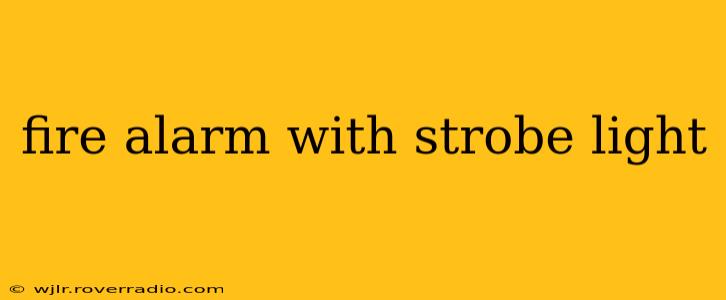Fire alarms are crucial for safety, and the addition of a strobe light significantly enhances their effectiveness, especially for individuals with hearing impairments. This guide will delve into the importance of strobe lights in fire alarm systems, addressing common questions and concerns.
What is a Fire Alarm with a Strobe Light?
A fire alarm with a strobe light combines the familiar audible alarm with a visually flashing light. The strobe, typically a bright, pulsating light, provides an alternative warning signal, ensuring that individuals who are deaf or hard of hearing, or those whose hearing is impaired due to a noisy environment or sleep, are alerted to a fire emergency. This dual-warning system drastically increases the chances of timely evacuation.
How Does a Strobe Light Enhance Fire Safety?
The addition of a strobe light dramatically improves fire safety by:
-
Alerting the Hearing Impaired: This is the most crucial function. Individuals who rely solely on hearing may not be awakened or alerted by an audible alarm alone. A strobe light penetrates sleep and noise, providing a visual cue.
-
Providing Redundancy: Even individuals with normal hearing benefit from the added visual warning. The strobe light serves as a backup alert, ensuring that the alarm's message is received even if the audible alarm is malfunctioning, blocked by noise, or simply overlooked.
-
Increased Visibility in Smoke-Filled Environments: Smoke significantly reduces visibility. A bright strobe light cuts through the smoke, making it easier to locate exits and follow escape routes.
What are the Different Types of Strobe Lights Used in Fire Alarms?
Strobe lights integrated into fire alarms vary in intensity and frequency. The specifics are often regulated by building codes and safety standards. Generally, they are designed to be highly visible and attention-grabbing. Some key features might include:
-
Intensity: Measured in candela (cd), this indicates the brightness of the strobe light. Higher candela values mean greater visibility.
-
Flash Rate: The frequency of flashes per minute. This is usually standardized to ensure effectiveness.
-
Synchronization: In larger systems, multiple strobe lights can be synchronized to flash in unison, creating a more noticeable and coordinated warning.
Are Strobe Lights Required by Law?
Building codes and fire safety regulations often mandate the installation of strobe lights in conjunction with audible alarms in specific locations, particularly in areas designated for people with disabilities. The exact requirements vary depending on the location and type of building. It is essential to check local codes and consult with fire safety professionals to ensure compliance.
How Often Should Strobe Lights Be Tested?
Strobe lights, like the rest of the fire alarm system, need regular testing and maintenance to ensure they function correctly when needed. Testing frequency is usually specified by local regulations or by the system's manufacturer's recommendations. Regular inspections often involve visually checking the strobe light for any damage and performing functional tests to verify its flashing ability.
Can I Install a Strobe Light Myself?
While you might be able to purchase and install a standalone strobe light, integrating it into an existing fire alarm system is a complex process that typically requires a qualified electrician or fire alarm technician. Incorrect installation can compromise the system's effectiveness and potentially void warranties. Always consult a professional.
Where Should Strobe Lights Be Placed?
Strategic placement is critical for maximum effectiveness. Strobe lights should be positioned where they are clearly visible from all sleeping areas and common escape routes. They should also be placed in accordance with local building codes and fire safety regulations.
This guide offers a comprehensive overview of fire alarms with strobe lights. Remember, safety is paramount; always prioritize proper installation, regular maintenance, and adherence to local regulations. Consult with professionals to ensure your fire alarm system meets all safety standards and provides the best protection for everyone in your building.
